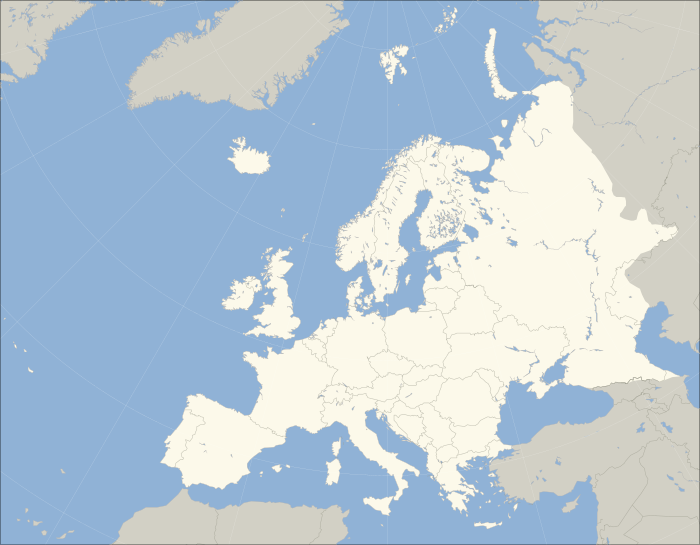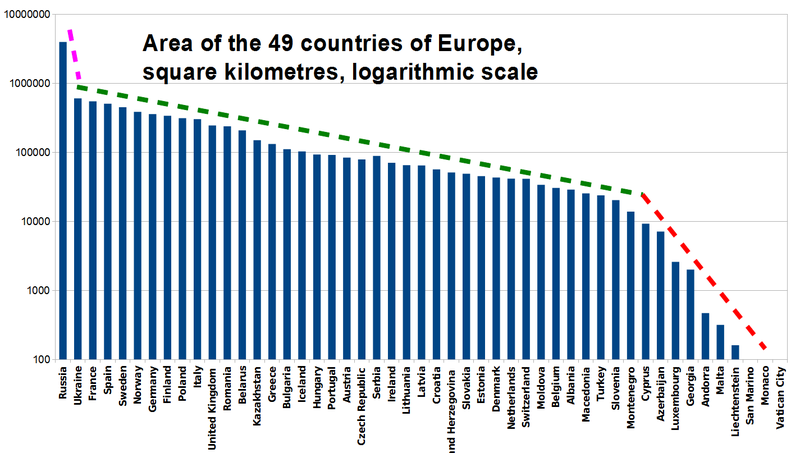List of European countries by area
Below is a list of European states, in order of their geographical area. As a continent, Europe's total geographical area is about ten million square kilometres.[1]
Some states (marked *) are transcontinental countries. Those are ranked according to the size of their European part only.
The list includes only sovereign states.
Inland water is included in area numbers.
Table[]
European states by area
| Rank | State | Total area (km2) | Total area (sq mi) | Notes |
|---|---|---|---|---|
| 1 | 3,969,100 | 1,532,500 | 3,995,200 km2 (1,542,600 sq mi) including the disputed territory of Crimea; 17,098,242 km2 (6,601,668 sq mi) including Siberia.[2] | |
| 2 | 603,628 | 233,062[3] | Including Crimea. | |
| 3 | 551,695 | 213,011 | 643,801 km2 (248,573 sq mi) when the overseas departments are included. | |
| 4 | 498,511 | 192,476 | 505,990 km2 (195,360 sq mi) when the Canary Islands, Ceuta and Melilla are included.[4] | |
| 5 | 450,295 | 173,860 | ||
| 6 | 385,178 | 148,718 | Including Svalbard and Jan Mayen.[5] If they are excluded, continental Norway is 323,779 km2 (125,012 sq mi) in area. | |
| 7 | 357,386 | 137,988[6] | ||
| 8 | 338,145 | 130,559 | ||
| 9 | 312,685 | 120,728 | ||
| 10 | 301,338 | 116,347 | ||
| 11 | 242,495 | 93,628 | Not including British Overseas Territories or Crown dependencies. | |
| 12 | 238,397 | 92,046 | ||
| 13 | 207,600 | 80,200 | ||
| 14 | 148,000 | 57,000 |
Territory west of the Ural River is counted as in Europe; 2,724,902 km2 (1,052,091 sq mi) including Asian part | |
| 15 | 131,940 | 50,940 | ||
| 16 | 110,994 | 42,855 | ||
| 17 | 102,775 | 39,682 | ||
| 18 | 93,030 | 35,920 | ||
| 19 | 88,416 | 34,138 | 91,568 km2 (35,355 sq mi) when the Azores Islands and the Madeira Archipelago are included. | |
| 20 | 83,858 | 32,378 | ||
| 21 | 78,866 | 30,450 | ||
| 22 | 77,453 | 29,905 | 88,361 km2 (34,116 sq mi) including Kosovo | |
| 23 | 70,273 | 27,133 | ||
| 24 | 65,300 | 25,200 | ||
| 25 | 64,589 | 24,938[7] | ||
| 26 | 56,594 | 21,851 | ||
| 27 | 51,129 | 19,741 | ||
| 28 | 49,036 | 18,933 | ||
| 29 | 45,339 | 17,505 | ||
| 30 | 44,493 | 17,179 | Figure includes the Faroe Islands. Including Greenland it would be 2,210,579 km2 (853,509 sq mi). Continental Denmark is 43,094 km2 (16,639 sq mi) in area. | |
| 31 | 41,290 | 15,940 | ||
| 32 | 41,198 | 15,907 | Excluding Caribbean Netherlands, Aruba, Curacao and Sint Maarten; combined into the Kingdom of the Netherlands, its total area is 42,531 km2 (16,421 sq mi). | |
| 33 | 33,846 | 13,068 | ||
| 34 | 30,510 | 11,780 | ||
| 35 | 29,743 | 11,484 | Geographically part of Asia, but can be considered culturally European | |
| 36 | 28,748 | 11,100 | ||
| 37 | 25,713 | 9,928 | ||
| 38 | 23,764 | 9,175 | 783,562 km2 (302,535 sq mi) including Asian part | |
| 39 | 20,273 | 7,827 | ||
| 40 | 13,812 | 5,333 | ||
| 41 | 10,887 | 4,203 | Partially recognised state | |
| 42 | 6,960 | 2,690 | 86,600 km2 (33,400 sq mi) including Asian part | |
| 43 | 5,896 | 2,276 | A Mediterranean island near Turkey in the Middle East; does not have sovereignty over the whole of the island of Cyprus (total area of 9,251 km2). | |
| 44 | 2,586 | 998 | ||
| 45 | 2,428 | 937 | 69,700 km2 (26,900 sq mi) including Asian part | |
| 46 | 468 | 181 | ||
| 47 | 316 | 122 | ||
| 48 | 160 | 62 | ||
| 49 | 61 | 24 | ||
| 50 | 2 | 0.77 | ||
| 51 | 0.44 | 0.17 |
Definition[]
Europe and Asia are contiguous with each other; thus, the exact boundary between them is not clearly defined, and often follows historical, political, and cultural definitions, rather than geographical.

erland
Atlantic
Ocean
Clickable map of Europe, showing one of the most commonly used continental boundaries[8]
Legend: blue = Contiguous transcontinental states; green = Sometimes considered European but geographically outside Europe's boundaries.
Range[]
The area of European countries varies widely, over several orders of magnitude:

See also[]
- List of European countries by population
- Area and population of European countries
- List of African countries by area
- List of Asian countries by area
- List of North American countries by area
- List of Oceanian countries by area
- List of South American countries by area
References[]
- ^ "Map and Details of all 7 Continents". WorldAtlas. Retrieved May 4, 2019.
- ^ "The World Factbook - Central Asia - Russia". CIA World Factbook. Central Intelligence Agency. Retrieved 3 May 2019.
- ^ "Ukraine". United Nations in Ukraine. Retrieved 2020-02-14.
- ^ "Entorno físico y medio ambiente" (PDF). Instituto Nacional de Estadística. p. 10. Retrieved 4 August 2019.
- ^ "Updated land cover figures". ssb.no. Retrieved 2015-11-21.
- ^ "Fläche und Bevölkerung". www.statistikportal.de (in German).
- ^ "Latvia country profile". 29 March 2019. Retrieved 2019-10-28 – via www.bbc.com.
- ^ The map shows one of the most commonly accepted delineations of the geographical boundaries of Europe, as used by National Geographic and Encyclopædia Britannica. Whether countries are considered in Europe or Asia can vary in sources, for example in the classification of the CIA World Factbook or that of the BBC. Certain countries in Europe, such as France, have territories lying geographically outside Europe, but which are nevertheless considered integral parts of that country.
- Lists of countries in Europe
- Lists by area
- Lists of countries by geography